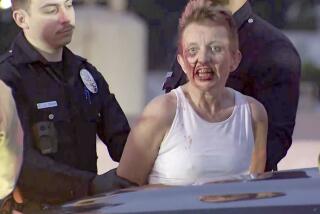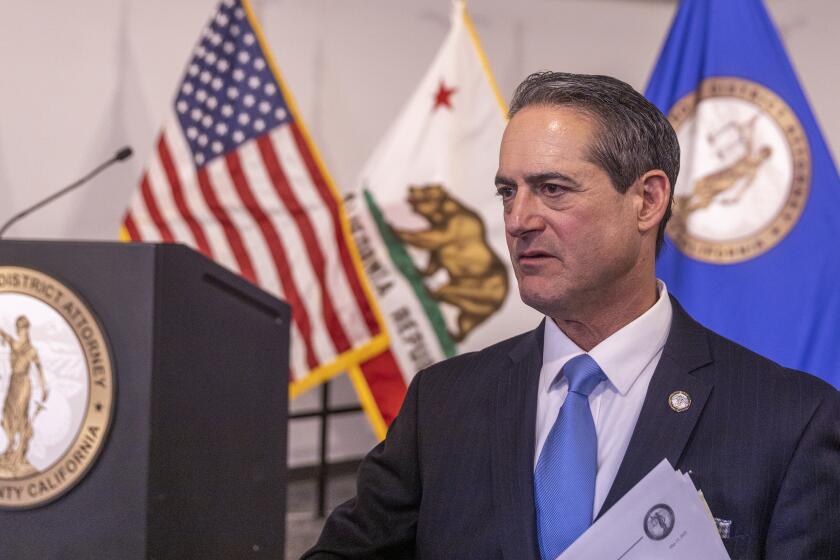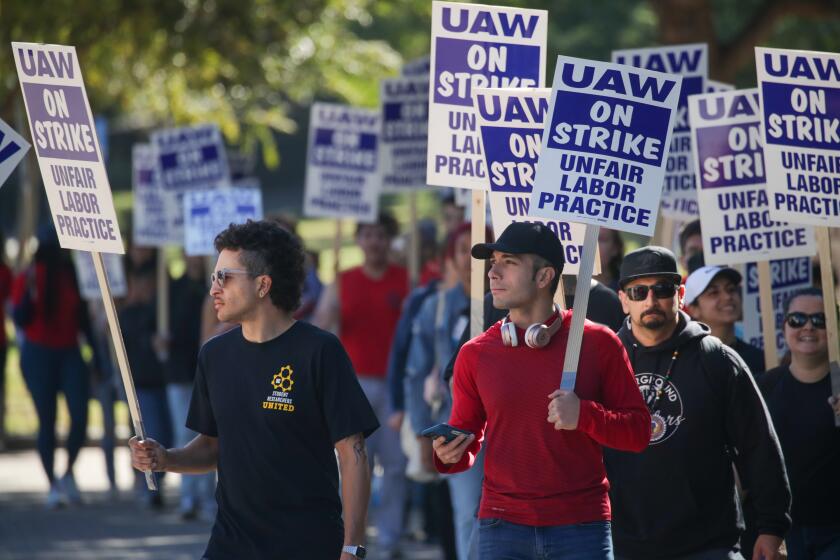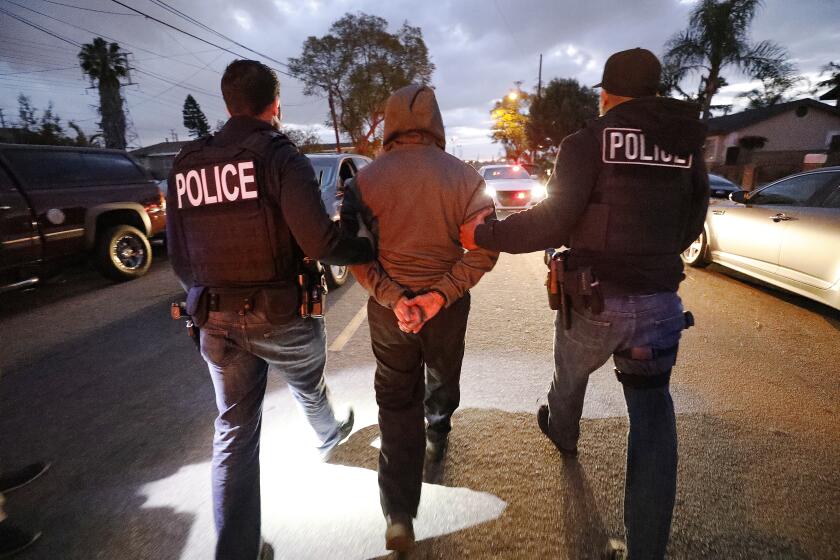Calls for Assistance Hung Up in Overburdened 911 System
You can hear the weary desperation in the man’s voice: “Every day I call the police, and every day the police don’t come.”
He is complaining -- again -- to a 911 operator about the dirt bike riders who are squealing their tires up and down the hill behind his South Los Angeles apartment.
“I know there are people getting burglarized and robbed, but I have my rights too,” the man tells the operator, who is patiently taking a report. “It disturbs my quality of life.”
It’s a familiar refrain for the operators who answer the nonemergency phone lines in the Los Angeles Police Department’s 911 dispatch center across the street from Parker Center downtown. Working in a stuffy office four floors below ground, the operators receive thousands of calls a day.
Some callers receive police assistance. Others never do.
The reasons vary. Some people simply call the wrong number: The tree branch that snaps off into the street is not an LAPD problem but a street services one. Others call about problems that the police are too busy to address immediately: An officer cannot make it to the scene of a hit-and-run car crash in which no one has been hurt.
The calls that get no response, however, lead to criticism of the LAPD, and have helped drive the San Fernando Valley and Hollywood secession movements.
Some view the LAPD as unresponsive, out of touch with the communities it serves. It is at least 1,000 officers short, with recruitment only recently starting to improve. As a result, response times are lengthy, while the crime rate is increasing.
The LAPD has been rocked by the Rampart corruption scandal and the department now operates under a federal consent decree, negotiated to ensure changes are made.
Public safety is a touchstone for leaders of the secession efforts. Voters will decide Nov. 5 whether to create separate cities for Hollywood and the Valley, and organizers of the secession campaigns say public safety is the main reason people support them.
“People don’t feel there’s enough of a presence of law enforcement,” said Richard Katz, a former state assemblyman and a Valley secession leader. “They don’t see enough black-and-white patrol cars, they don’t see enough senior lead officers.”
If secession is approved for the Valley, organizers say, Los Angeles still would provide police services for at least the first 18 months after the vote. The new city would contract with the LAPD until a new mayor and city council decided how to handle public safety.
Their options would be to create a Valley police department, continue to contract with the LAPD or some combination of the two. Some also have suggested that a new city could contract with the Los Angeles County Sheriff’s Department. A Hollywood city would likely contract with the LAPD for law enforcement services.
Some secession backers believe the Valley would be best off with its own police force. And they believe they would not have the same problems recruiting officers.
“I’m very confident that, if the council and the mayor decided to establish a police department within the San Fernando Valley, that would be a very attractive department for police officers,” said Keith Richman, a candidate for mayor in a Valley city. “Salaries and benefits would be competitive. It would be a good place to work.”
Reducing the LAPD’s lengthy response times to emergencies would be a main priority for the new cities, secession leaders say. The department’s citywide average is a 10-minute response. For calls deemed nonemergencies, waits can be much, much longer.
At one point at the 911 center recently, 38 people were awaiting officers for a variety of reasons. One caller had been waiting 59 minutes after reporting a trespasser. Another was still waiting 36 minutes after calling about a family dispute. A third, who had reported a fight between neighbors, was waiting 39 minutes.
The response time problem mostly comes down to a combination of the city’s size and the relative thinness of the LAPD’s ranks.
The department says the large area it covers -- coupled with the volume of emergency and nonemergency calls -- are impediments to quicker service.
Supporters of smaller cities point to Burbank, Glendale and Pasadena as examples of police departments that can handle emergency and nonemergency calls much faster.
In Burbank, for example, police respond to emergencies in about three minutes; in Glendale, response time is about five minutes; and in Pasadena, it’s four minutes.
But those cities are equivalent in some cases to just one LAPD division, and a Valley city, would be the sixth-largest in the country.
The Foothill police station in the northeast Valley, for example, serves 262,000 people and covers more than 61 square miles. Its response time is 10.4 minutes, according to the most recent LAPD reports. Pasadena, by contrast, has about 141,000 people. Foothill has about 350 officers and Pasadena has 247.
The Los Angeles County Sheriff’s Department, which is roughly the same size as the LAPD, has a response time of less than five minutes. New York, Houston and Philadelphia all have shorter response times as well.
Secession leaders say they would set different public safety priorities, requiring more community policing aimed at tackling smaller, neighborhood problems before they become larger ones.
It is a theory strongly endorsed by the LAPD’s new chief, William J. Bratton. He is a former New York City police commissioner who oversaw that city’s police department during years of dramatic decline in crime. He says that crime and response times in Los Angeles can be reduced on his watch.
But secessionists aren’t so sure. They point to the numbers: in New York City, Bratton had 38,000 police officers, here he has 9,000. In New York, he had 209 residents per officer, here there are 409.
Los Angeles officials, who have long grappled with how to ease the burden on the 911 system, have created a new telephone line for nonemergency calls. When it is operational, the 311 service will shift the volume of calls to a new group of operators, but it probably won’t do much to reduce LAPD response times.
The city has attempted this before. In June 1999, the LAPD introduced a new, toll free nonemergency number, (877) ASK-LAPD, in an attempt to free some 911 lines. But that line was barely promoted, and relatively few people actually know to use it. Police stations also have seven-digit nonemergency phone numbers but, again, those are not used as much as LAPD officials would like.
Instead, the calls come flooding into the 911 center: There’s a signal light out on Foothill Boulevard. What’s the phone number for the Hollenbeck station? I need a copy of an accident report. One 911 operator described her job as “essentially 411.”
In November, however, city officials plan to unveil the 311 service. It is a multimillion-dollar endeavor, years in the making, that will be a kind of one-call-to-City Hall service. Operators will transfer calls to city departments and eventually take reports themselves.
There’s one catch. As Deputy Mayor Doane Liu put it: “This doesn’t make the response any quicker; this makes the call to the right department quicker.”
In other words, if 311 works, callers won’t get switched around. A PricewaterhouseCoopers study commissioned by the city found that half of the nonemergency calls are transferred at least twice before the callers receive answers or submit requests.
Under the 311 system, calls for street services, the Department of Water and Power and tree trimming, among many others, will be handled by non-911 operators.
“This is another one of the ways that Mayor [James K.] Hahn wants to improve city services, whether you live in the Valley or South-Central or the Harbor,” Liu said.
And even the secession supporters are happy about that.
“It certainly can help,” Katz said. “All you hear are stories of how difficult it is to get 911.”
It is especially difficult for someone calling from a cellular phone. Most of those calls are routed directly to the California Highway Patrol. The 311 system also won’t be accessible from cell phones any time soon.
Meanwhile, the calls keep flooding the 911 lines. The other day, one operator took 24 calls in an hour.
One man actually apologized for calling. “I call all the time,” he said. “I’m not sure where I’m supposed to call. There’s a woman selling things from a grocery cart on my street every afternoon.
“Look,” he said finally, “is there some place I can call for these kinds of things? I know it’s not you ... because you never come.”
*
Last in a series of stories on Los Angeles city services.
About This Series
Today, The Times concludes its six-part series on Los Angeles city services with a report on police response to emergency and nonemergency calls.
Previous stories from this series are available on The Times’ Web site at www.latimes.com/secede.
More to Read
Start your day right
Sign up for Essential California for news, features and recommendations from the L.A. Times and beyond in your inbox six days a week.
You may occasionally receive promotional content from the Los Angeles Times.






